
Chapter 11
Radio and Television on the Internet
by Mike Adams and Daniel Fortune
![]()

by Mike Adams and Daniel Fortune
![]()
Radio and Television on the Internet
Applications for Broadcasting on the Net Now
Real Uses of the Intenet by On-Air Broadcasters
Real Uses of the Internet by Networks and Cable Programmers
A Case Study - KOME-FM and the Internet
Video on the Internet - A Radio Broadcaster's Experiment
Two Case Studies - Innovative Uses by Television of the Internet
What Does this all Mean to You?
![]()
In the 1950s it was Canadian media theorist Marshall McCluhan who said that in the beginning each new media resembles an old ones it purports to replace. For example, didn't the very first moving pictures resemble the dramatic stage play, vaudeville and the live magic show? It took several decades for movies to actually take advantage of a "moving" camera and the concept of the shot.
It began as "radio with pictures." That same process is already happening with Internet. It was only a few years ago that the World Wide Web of the Internet discovered it could be just like another familiar media format - the magazine. So the question might be, "Will the Internet continue its march from a magazine with still pictures approach to full audio and video broadcasting?" Or more practical, "How will broadcasters really use the Internet.
That is the question that radio and television stations, networks, cable programmers and others have been asking for several years. Those companies formerly involved in the traditional broadcasting of entertainment and information are looking closely at the Internet as a way to expand their audiences and reinforce existing audiences. In this chapter, you will learn about how radio and television people now see the Internet, what sorts of technology they are trying, what they have learned, and how they answer the big question, "How can we make money at this?"
Also, discover what the authors of this book have learned after their year-long experimentation with an unusual marriage of broadcast radio and video. And as ways, along with the text, find out what exists, actually hear it and see it, using our companion New World Media website. There are listings of URLπs throughout the chapter and actual links on the New World page. List or link, it's all here, there, and it's part of your future as a media production professional. Finally, at the end of this chapter, you will have the chance to create a simple broadcast application for your own web page, and launch it for all New World media participants to see.
With the Internet it's always difficult to separate the hyperbole and the dreams from the reality of what is actually being created and utilized. While broadcasters are talking a great deal about Net Broadcasting, what are they really doing about it? Which broadcast-friendly uses for the Internet have been tried, tested, embraced or discarded? There are more than you realize. It was less than a year ago that a major trade group, the National Association of Broadcasters began to add Internet sessions to their common conference fare of programming, regulation, legal and equipment topics. After attending a number of those sessions, the pattern that emerges is that Internet applications currently being tested by radio and television broadcasters fall into two broad categories: primary and secondary or supplemental.
Primary applications have included attempts to have entire broadcast schedules, either audio, video, or both, squeezed into what most believe is too little available bandwidth. As you will learn, and actually discover for yourself through our website, programs such as Real Audio, StreamWorks and CU-SeeMe have great potential in concept, and deliver an actual quality far from what you have come to expect even from the most basic television and radio receiver. For now, and for a number of reasons, the technology is lagging a bit behind the hope.
However, as enhanced technology is adopted by the major players including Microsoft and Netscape, the primary issue of limited viewership over exiting bandwidth is changing dramatically. Also as bandwidth becomes more plentiful with the accessibility of blazing fast fiber rings that handle massive amounts of data are available to the public for far lower costs, great changes will occur. As in any technology, supply and demand determine the price, and as supply has been scarce, the price has been high. As supply increases dramatically, and the cost of technology drops, the consumer will be the eventual winner in the technology race. For example, look at color televisions and VCR's!
The hopeful news is that there are a number of innovative secondary applications for which broadcasters have almost unanimously embraced the current potential of the Internet. On our website you will discover what works well, what is technically possible, and in the text that follows you'll begin to see several use patterns emerging.
This common co-sponsorship of public events is something that a successful radio and TV station has long embraced, and the top rated stations are very good at it. How many times have you seen the brightly decorated van owned by your favorite radio station drive up to a mall or concert venue, and either broadcast live or give away T-shirts, stickers and key chains bearing the stationπs logo? Or have you wondered why the local television station would leave the comfort and security of the studio to stage their evening newscast at a local park? The reason is local promotion. In the past few years much of this promotional effort by broadcasters has been put onto the Internet.
First look at radio. Visit three top-rated Bay Area radio stations and notice how similar their web presence seems. KOME, a modern rock station (www.kome.com), KSJO, a traditional album rock station (www.ksjo.com), and KYLD, urban/hip hop (www.wild107.com). All three, while graphically and stylistically different, use the web in the following three ways:
In Figure 1 Below, Daniel Fortune is shown with Dr. Drew, co-host of LoveLine, a popular radio call in talk show. In cooperation with Infinity Broadcasting, Daniel Fortune and the Broadcast Production Group produced the LoveLine ≥netcast≤ via the Internet, using chat features of the KOME web site, and streaming digital audio and video. Participants could ≥tune-in≤ via the web. This netcast represented a primary foray into digital broadcasting for the Infinity Broadcasting Group, and was shown to dramatically increase the participant usage of the KOME Web site, as described later in the chapter.
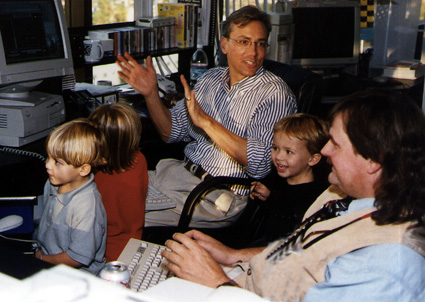
Figure 1. Daniel Fortune with LoveLine Host Dr. Drew (and Dr. Drews triplets), during a radio/internet simulcast
Using the web, these stations are able to add the details behind the headlines and the pictures and trends behind the fifteen second on-air weather announcement. Whether a stationπs format is music or information, all use the Internet to both reinforce their existing audience and serve new ones. And just like their main business of broadcasting, stations are seeking a way to attract paying sponsors to these efforts.

Figure 3. Radio Free Berkley, voice of pirate radio
Non-commercial stations do not have to be as relentless in their constant promotion, but they still have an audience to reinforce, perhaps a base of paying members who join during the frequent on-air pledge drives. Public radio and TV giant KQED (www.kqed.org) will custom e-mail their program schedule every week. And along with usual news and schedules found on both their radio and television stations, they add to it a number of interesting features related to broadcasting.
One is a feature on old radios themselves, and another a feature page on 1940s band leader Kay Keyser. Interesting information, designed not for the hard promotional sell like that of a commercial station, but rather to make those that donate to or join the station as members feel like they are getting some unique knowledge. At listener supported KPFA (www.kpfa.org) the unique features are community events coverage that mirrors their broadcast service, that of an alternative talk station. Unlike commercial popular music stations, the large public broadcasters know from their demographic surveys that their audiences are better educated, have higher incomes, and are much more likely to be on-line.
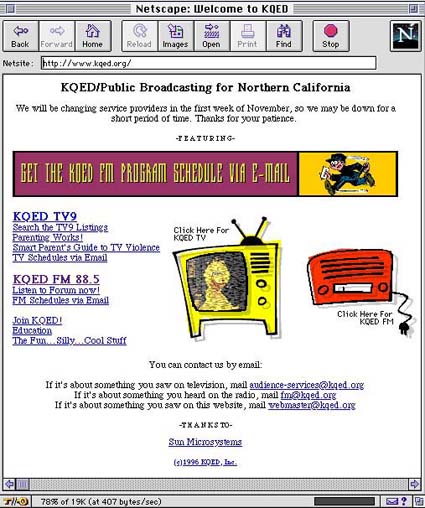
Figure 4. Non-commercial KQED in San Francisco
The major broadcast networks (www.cbs.com, www.nbc.com, www.abc.com, www.pbs.org) have put a great deal of innovative production into their sites with the main goal one of promoting and reinforcing their programming.

Figure 5. The CBS Network Home Page
Two major companies, one television and the other software, have invested heavy resources into making sure that the connection between the television audience and that of the computer becomes reality. NBC and MicroSoft now have MSNCB (www.msnbc.com), with a web service that is a hybrid between a news magazine and an all-news cable channel, and a cable channel that tries to be a cross between television and the Internet. Will it work? Are there already too many existing news magazines, news papers and other similar fare available? Perhaps like the home shopping channels of the 1980s, only one or two major players will survive. MicroSoft and NBC are betting that when the smoke clears they will be the major service.
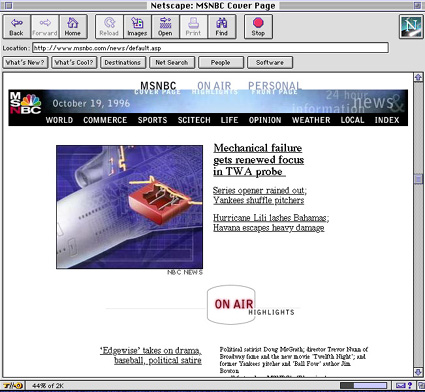
Figure 6. The New Television and Internet Broadcaster from Microsoft and NBC
Some of the early news and information cable users of the web have very mature services. CNN (www.cnn.com) offers a companion web site for their news programming, while non-commercial C-SPAN (www.c-span.org), as the "political network of record" is of great value during the national election campaigns. The cable channels (www.discovery.com, www.cnet.com, www.disney.com, www.hbo.com), and many others use their web services to reinforce their televised content.

Figure 7. C-Span Home Web Page
The most recent listing of radio and television stations on the web show that after just a few years, more than half of all licensed stations and all the major broadcast and cable networks now have an Internet presence. Why is this? Why this rush to get online by mass media organizations that routinely get viewers and listeners numbering in the millions? Why spend all this production time and money on an seemingly unrelated endeavor?
The answers are complex: First, as technology and the accompanying press accelerates, most broadcasters probably believe that they must do it so as not to miss out or seem backward to their important base of local listeners and viewers. Second, we just do not know if, when or whether the Internet will actually rob the traditional media of their long held audiences. And finally, there is the "gold rush" mentality of the Internet, one that promises that some of the players will get very rich. Broadcasters just want their share.
KOME, which is owned by Infinity Broadcasting, and is known for their hot syndicated broadcast property, Howard Stern. KOME had built a first generation Internet Web Site, which received little attention, and infrequent updates. Proposals for a second generation web site were presented to KOME, which included the ability to broadcast programming over the Internet via digital streaming audio and video. Infinity expressed reluctance to expose programming over the web was based on the concept their content is the financial essence of Infinity. Consequently they did not want their programming broadcast worldwide over the Internet.
Crucial decisions were made between the Program Director and the Station Manager, both of whom had the foresight to see that the web was the up and coming medium for the world, and in particular their demographics. In conjunction with the Broadcast production Group, they decided to launch an aggressive second generation web site.
With the next generation KOME web site, their unique visitor count went from 100 per day to upwards of 10,000 per day as a direct result of on the air promotions.
The site has won numerous awards for creativity and uniqueness, and is ranked among the top 40 sites in the nation.
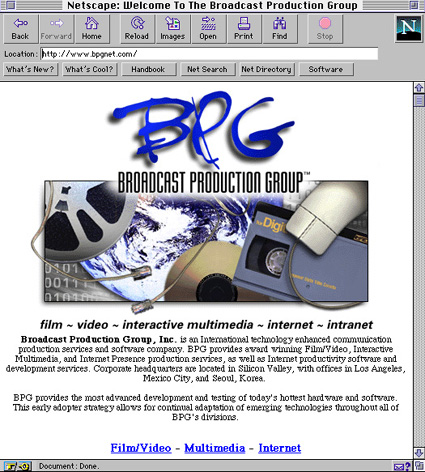
Figure 8. Sample Broadcast Production Group home page, producers of the KOME Web Site
You may have heard of RealAudio, a downloadable program in use for several years. Using it, an actual licensed broadcast station or an Internet-only station is able to send their programming to anyone in the world equipped to hear audio over a computer connected to the Internet. You may also think that licensed broadcasters would be lining up around the block to take advantage of this fairly inexpensive service. You would be wrong. While the Real Audio service has been in existence for four years, most of its clients are Internet-only audio services, while less than a hundred broadcasters have signed up. The reason is the nature of radio; most of the 12,000 AM and FM stations on the air today care only about their local audience, the same audience sought by their mostly local advertisers. And while a low-power college or cable station might see a fun advantage in being heard around the world, there is little monetary gain.
A list of the RealAudio services (www.timecast.com/sites/alpha.html) reveals that the majority are experimental, narrowly focused and promotional audio services designed strictly for the Internet. To an established, licensed radio station, their listeners are in cars, at the beach, at work, maybe at home. Their audience is best served through that mature delivery system invented by EH Armstrong in 1935, FM.
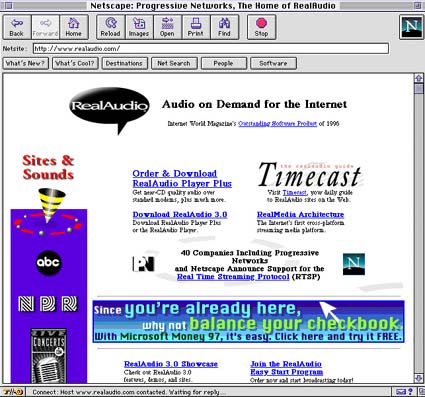
Figure 9. Real Audio Home Page
RealAudio "streams" packets of computer data representing the audio signal sampled. Radio stations and other RealAudio providers send their programming to a host computer, called a server. Using a modem and a Internet browser, a user goes to the RealAudio website and downloads a program, called a player. The program downloaded interacts with the browser, and every time a real audio file is clicked on, the server is contacted and the audio file is downloaded and played through the speakers. This is how RealAudio describes its features:
Real Audio was one of the pioneers in streaming audio over the Internet, and consequently has gained many inroads into the technology.
If the existing programs like RealAudio, TrueSpeech, Toolvox or technologies yet to be developed will make the reception of a radio station's programming over a home computer a common occurrence, will more stations embrace this technology? The question can be answered by understanding the goals and purpose of the local radio station. First, is there local competition? Remember, more than anything, a local station must use its transmitter and its promotional skills to get as many folk as possible to tune in. Even if a broadcaster was able to reach the entire world, as they are today, would it matter? Does the owner of Joe's Pizza in Anytown USA care if there are listeners to his commercials in England? Would one more pizza be sold using the Internet? That has always been the question.
Live, full motion video is just now getting to the Internet, and some broadcasters are leading the way with mostly experimental ventures. Like actual audio over the Internet, most computer users do not yet have the technology to receive it. But that's just because this generation of home computers has yet to catch up. As people replace their PCs, the new ones will be fast enough to handle video, much of it of with a quality no different from regular television. One use of video by broadcasters that is available to every computer user with even the slowest modem is that of the "web cam." Basically a small video camera trained on the broadcast studio or the news room, a single frame image from the camera is grabbed every five or ten minutes, sent to the users server as a jpeg image, where it can be called up by clicking on the appropriate on-screen icon.
Still video frames have long been a feature of the Internet. Actual video is another story. Beginning with the early application called QuickTime movies (www.quicktime.com), most web users got used to the idea that moving pictures over the Internet had to be low resolution, slow and jerky, not much better than the images from the hand cranked films from the early part of the century. And besides, a QuickTime movie had to be downloaded before it could be viewed, hardly a "live" format. To you in television production, with your Betacam SP's and digital video formats, the knowledge that there was video on the web did not seem to generate much enthusiasm. But actual moving video on the Internet, while it has been around for several years, was just not available as a mass medium for one very good reason: Bandwidth. Neither your computer nor your 14.4 kbps modem was really adequate to the task of television at 30 frames per second. One or two frames maybe, but never thirty.
One of the earlier users of the updated web snapshot/video frame is a tiny station in Watsonville, California. KPIG, that's right, K-Pig (www.kpig.com) has its "ham cam" right on its main page.
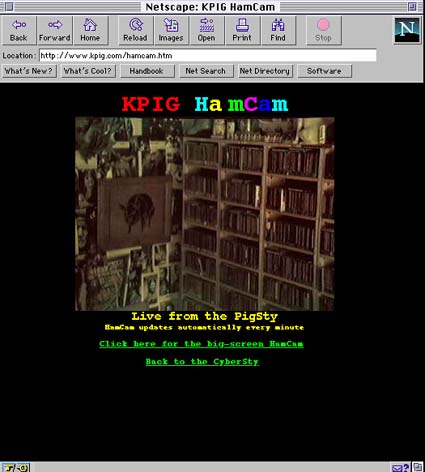
Figure 10. The KPIG Ham Cam" shows an updated photo of the KPIG studio, and occasionally you can see the on air DJ
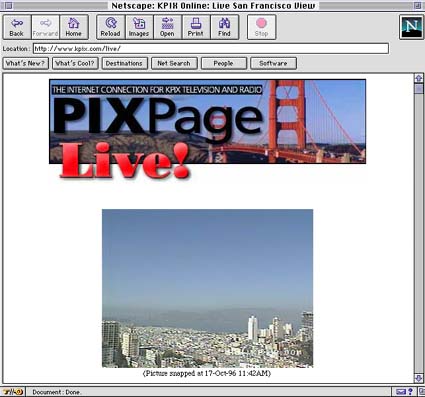
Figure 11. The KPIX "Tourist Cam" view of San Francisco
One of the original video (with audio) programs, called CU-SeeMe, was developed by Cornell University (www.cornell.org/pub/video) and recently licensed and sold to White Pine Software (www.wpine.com). Now here is an example of a technology that was really designed to be a one to one and one to many video conferencing software, but ended up having life of its own. Rather than being embraced by business as an alternative to expensive satellite-based video conferences, it has gained popularity as a video "chat" format. And as in the example later in the chapter, this technology has been used by broadcasters as well.
Other existing video formats for the Internet are Streamworks (www.xing.com) and VDOLive (www.vdonet.com). Now Netscape, the web browser company (www.netscape.com) has announced a format called LiveMedia, and they are determined to make it the standard.
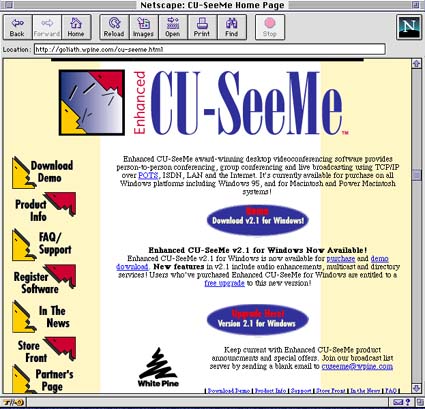
Figure 12. The WhitePine CU-SeeMe home page
For the past year a unique experimental project has been underway at San Jose State University's instructional FM radio station. The KSJS-FM/CU-SeeMe project has already re-defined the relationship between traditional over-the-air broadcasting and the Internet. For the past year KSJS has been simulcasting over the Internet the audio of its programming along with video from a variety of local sources. Even now, they are currently the only radio station in the world to use the full interactive audio and video capabilities of the Internet as an integral part of a broadcast schedule and for-credit course offerings within the Radio-TV-Film degree program.
It was believed that the elements of this "marriage" between old and new media delivery systems would: (1) extend the range and influence of KSJS and the university, (2) develop and reinforce both current and new audiences, (3) promote student learning of new uses of multi-media software and related technologies, (4) serve formerly undeserved segments of the local community, and (5) add to the overall influence of the arts and humanities. As a result of the experiment, KSJS-FM is already known in the Bay Area and worldwide as an "Internet broadcaster."
Many of the components of the KSJS-FM/CU-SeeMe Project can be best defined as student programmers interacting directly with both the radio and Internet audience in the areas of entertainment and community service. Four broad music formats and their companion cultural/public service content represent under served audiences within the Bay Area: Latino, African American, Jazz and Experimental/New Rock. Within these formats there are public affairs programs designed to appeal to and connect with the listener to each format. A partial list: "Sound Bytes" (computer-Internet), "Essencia" (Woman's issues), "Diagonally Speaking" (Gay and Lesbian), "From the Right" (Campus Republicans), "A Race for the Times" (African-American), "Latino Spotlight" (Latino community issues) "The Green Party" (the environment), "Sports Weekly" (Spartan sports. Many of these shows are interactive with the audience using telephone and CU-SeeMe. All KSJS programming has been simulcast on the Internet 24 hours a day, 7 days a week.
As it has turned out, the original purpose of the software (business teleconferencing) has probably been overshadowed by its experimental applications. Offered free and with no restrictions, other organizations began to see its potential as a distribution media for arts, music, TV and radio. NASA
How does a person find out about CU-SeeMe? On-air announcements over KSJS and stories in the local press have instructed interested listeners and readers to first access the KSJS web service (www.ksjs.org) where they can learn about CU-SeeMe and link for free software for PC or Mac. You will also be linked to the KSJS Webmaster and the originator of this project, Dan Fortune
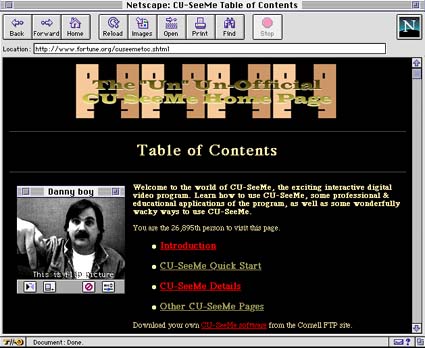
Figure 13. Daniel Fortunes CU-SeeMe Tutorial Home Page
Ongoing KSJS music programming over CU-SeeMe: The camera in the on-air control room allows 24 hour a day interaction between the student on the air and the Internet audience. Benefits: Students who have already participated in these exercises have received a great deal of international promotion via interested record companies and music trade publications that track and promote the various specialty music formats we air.
Did the students learn? Is there a future for live video of a radio station control room over the Internet? Is there a future for CU-SeeMe? Hey, one at a time!
There was initial excitement surrounding this project. Some students at the radio station began to seek training and then incorporate what they learned about the Internet into their programming. There was some early wonderment in their voices as they come out of the control room and shouted, "Hey, I've got a person in Japan watching my show." It was believed that students who originally came to KSJS to play music might spend hours creating or updating their web pages to announce their CU-SeeMe "debut" on the Internet. Only a few did this. The overall experience with video and the radio audience was interesting but alas, most radio programmers found they had to concentrate on that programming that directly served the local radio audience first, then if time permitted, some were interested in the Internet audience. Such is the nature and definition of radio today.
Formerly called the MacNeil-Lehrer NewsHour (www.pbs.org), this hourly staple on public broadcasting has always been an ideal candidate for the new media that has evolved out of the Internet. Unlike the news found on local stations and commercial networks where action and fast moving, short stories are done out of competitive pressure, the NewsHour is a slow-moving, but very detailed news broadcast. Long on content, it often features three to four 10 to 15 minute stories, most of these panels and interviews by news makers, politicians, academics and journalists. It was natural to put many of these longer interviews on the Internet, complete with the script and still frames from the video "talking heads."
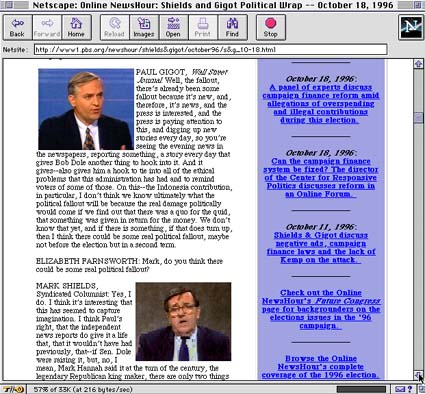
Figure 14. A Sample Story from a "NewsHour" Interview
The NewsHour actually works on the Internet because of the nature and format of the stories and the nature of the audience. In fact, the Internet version of the NewsHour is just as entertaining and informative as its television broadcast version, plus it can be downloaded, printed and studied. At the end of this chapter we offer a simple assignment, an exercise using many of the techniques from this PBS program.
Is the NewsHour's use of the Internet, carrying the entire story, text and pictures, innovative? Probably not. Not even high tech, no Java, no effects, no glitz. That, of course, is the point of the original program on which its web service is literally based. It is a straight news-interview show and to make it seem otherwise on the Internet would be wrong and probably alienate the audience. Again, decisions you'll have to make as a future video and multi-media production professional. You'll be the one who is called upon to evaluate a sponsor's content and recommend ways to present it using a variety of available media. You'll have an audience in mind, and you'll know what works for them.
Here is another example of how the Internet was used to expand the audience and content for a PBS historical documentary done by Professor Mike Adams, one of the authors of this book. The Herrold story was a small production and the one hour video was aired on PBS stations. As the producer of the project, Mike saw that as a video program designed for broadcast television, there was certainly a limited audience for the subject matter.
There was, however, a very loyal audience of hard core history buffs whom Mike believed wanted more detail from the documentary project. There were articles in academic journals and there is even a book forthcoming, but Mike wanted to use the Internet to link the known base of those interested in radio history with all the Herrold information Mike had. Two of these, (www.oldradio.com) and (www.antiqueradio.com) would send many of that audience to the additional material on Charles Herrold.
First, there was the usual promotional website for the video, really designed to get stations to request and air the show, still its greatest audience. Launched by the public television station that produced the project (www.kteh.org). It allows visitors to learn details about the production, learn about the producer, see actual stills from the documentary, even hear the only known recorded voice of Charles Herrold (1875-1948) There is a second valuable service which as the producer Mike felt could be of value to history enthusiasts, scholars and students. At (www.oldradio.com/archives/people/Doc_Herrold_TV_Show.html) the complete production script is reproduced for study of its historical content and the format of a documentary script.
A third piece of the Herrold history is found at (www.ksjs.org/adams/adams3.html). The unique patented Herrold water-cooled microphone is shown featuring detail not found in the video. The original Herrold notes, the actual patent drawings are accompanied by a complete breakdown of the parts of the device. After the video was done, Mike disassembled the microphone and carefully lit it in a television studio and photographed it with a 35mm camera and close-up lenses. Its parts are labeled and a brief narration accompanies each photo. This technical detail would have probably not have worked in the video but there are technical historians who need to know about it. Three ways in which a traditional video production was expanded for those audiences needing the detail not possible on broadcast TV, even non-commercial television. The published historical record is now more available to those who seek this sort of detail.
Will the technology improve? If so, will it matter if there is not enough bandwidth, and if home audiences continue to have slow modems? Will broadcasters realize that the Internet, while sexy, does not generate enough revenue to pay for it? Will you as a graduate of an enlightened and expanded audio and video program find that your first media job is in the Internet department of a radio or television programmer? Stay tuned!
When was the last time you saw a job offering in television and radio production? Published jobs in the field occur rarely. There is, however, one emerging trend in employment in broadcasting: The Webmaster. More than any time in the past, radio and television stations are actively advertising for people with the skills you are now learning, and it seems as if every radio and television station is rushing to get their web presence out there on the Internet. After years of the continuous downsizing of traditional radio and television jobs, stations are now adding a position or two in production for the Internet. Most services offered by these pioneering broadcasters are promotional in nature, a few involve interactive audio and video, and a few more use a downloadable program to connect those few with the needed technology to an audio server.
The point is, stations are now searching for someone just like you; a trained audio and video production person with the ability to transform some the content that is aired using radio and television into content that will appeal to the home computer audience. Stations are looking for a versatile production person, one that understands how to write a script, how to light a set, how to direct and how to make it work both for broadcast and the Internet. These broadcasters are looking for the edge, searching for new audiences, not wanting to get behind. And while none understand if or how the Internet will change the audiences for their over the air product, they all realize that the Internet will have some impact on the traditional business of broadcasting. These astute business people will not want to get left behind. They will seek your help. You will be ready.
PURPOSE OF THE ASSIGNMENT: This is a simple exercise that combines what you already know about a simple television interview show and what you need to know about adapting it to the Internet. Our example be found on our website. The purpose of this assignment is to learn how some of the major TV/Internet news providers take their traditional broadcasts and re-purpose them for the Web. See (www.msnbc.com and www.pbs.org) for examples.
A digital camera, or a way to grab selected frames from a videotape and import into your web publisher. Most non-linear video editing systems like Adobe Premiere Pro and Final Cut Pro allow this. Absent this technology, a 35mm camera and a scanner will suffice. Absent a scanner, most photo processors will develop your pictures and put them directly onto a disc. The quality of the image will be enhanced by using a studio, lights and a set used for a talk show.
Here is a variation of the interview project. Follow every step, except instead of "talking heads" you'll be working with the traditional documentary format. Write a narration script that describes a process, introduces a concept, shows operation of a piece of television equipment, offers a tour of an area, a building, etc.
The purpose of both exercises is to show an very old concept; how to select an appropriate media to best communicate content. In the past, if you went to an old-style audiovisual company with an idea for a media presentation, they might suggest overhead transparencies. If you went to photographer, he or she would certainly recommend that you use still photos or slides to tell your story, perhaps synchronized with a sound track. The same has long been the case with the video production company. Once the "new media," video producers began to see everything with motion, sound and effects, even if the subject matter would be more effectively produced using another media, say a book.
Now video companies have the chance to rethink the production process. Instead of the linear form that is television, still pictures and text on the web or an interactive CD-ROM might have a more useful life. Soon, the universal interactive nature of the Internet may even make the CD-Rom or corporate public relations or training video obsolete.
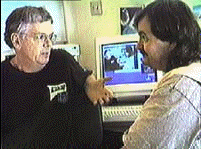
(MS, Mike, over shoulder Dan FG)
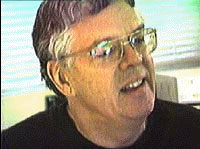
MIKE ADAMS: Dan, you and I have been watching the digital revolution for quite a few years, yours as a multi-media producer and me as a broadcast educator. It looks to me like the two fields are merging.
(CU, Dan)
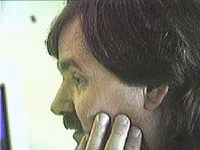
DAN FORTUNE: Right, Mike. And actually, it's happening faster that I would have believed just a year ago. It used to be that multi-media was a skill taught in university art departments and the jobs were concentrated in places like San Francisco's "multimedia gulch." Now the companies that use to do just video production are getting into it.
(CU, Mike)
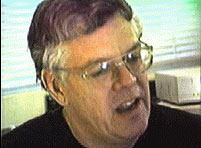
ADAMS: Same with video departments at the universities. It now seems like a natural for students who learn video production to learn production for the Internet. This must be going to affect the job future for the traditional radio, television and film student, especially as the Web gets better audio and video software, starts to move and talk like your TV set.
(2-shot, both)
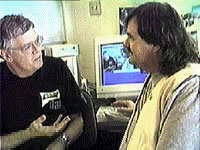
FORTUNE: It's the clients that are driving this thing. At the company where I work, we no longer just do corporate video. Now companies want interactive CD-ROMS and Intranet sites instead of the traditional linear video tapes. Television production graduates are in for a big surprise.
(MS, Adams holds magazine)
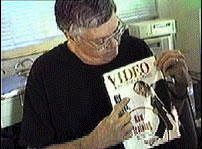
ADAMS: I want to show you this magazine called "Video and Multimedia producer.
(CU, Magazine cover)
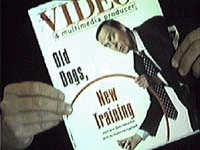
ADAMS: It used to be called just video producer. Now, like everything else about production, it has "morphed" into a digital production magazine. Their lead editorial says "The production business is changing and 74% of our subscriber base now produces multimedia projects in addition to their traditional video."
(MS, Dan)
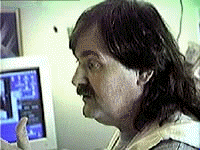
FORTUNE: It's here now and that is why we have published the book and website that you are using and watching. We want you to be prepared for the future. It's changing so fast it's scary.
(2-shot)
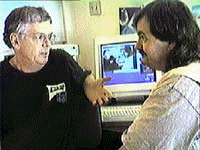
ADAMS: We'll be back in the next chapter with more inside information on the New World of production.